- This
precis tells-Did Khilji/Tughluq rule all of India, Timur invasion, what is
common between Timur and Vasco da gama, Religious Life then, Impact of Islam, Religious
life & Language/Literature and did Muslim ruler of Bengal support Chaitanya
Mahaprabhu.
Shri
V Balachandran (ex-Special Secretary Cabinet Secretariat) wrote in The Tribune
Chandigarh Neglecting
cultural czar Munshi’s efforts This goaded me to do a precis of
Foreword of 11 Volumes of The History and Culture of Indian People. We present
precis of Volume 6.
Respected
K
M Munshi was an educationist, freedom fighter, founder of Bharatiya
Vidya Bhavan (1938), author and worked closely with Sardar Patel. He initiated
the writing of The History and Culture of
the Indian People. The books are a masterpiece & my constant reference
book. Shri R.C. Mazumdar was General Editor. Of volume 6, A.D. Pusalker and
A.K. Majumdar were Assistant Editors.
K
M Munshiji said, “That although efforts to prepare this massive history-writing
had started in 1938, it could assume concrete shape only in 1944 with generous
help from GD Birla and the Shri Krishnarpan Charity Trust.”
Precis
is split in parts. Each part has a number and title that represents content.
Let us hope these books become part of the mainstream educational system.
Part
1 covered period 1000-1300 and includes state of Indian society around 1000,
why did it survive the earlier 2,000 years, status of Sanskrit, social impact
of Muslim invasions, why lower strata of society adopted Islam, South Indian
kings, rise of Desabhashas and Bhakti.
Part
2 covers period 1300 to 1526. It tells did Khilji/Tughluq rule all of India, Timur
invasion, what is common between Timur and Vasco da gama, Religious Life then, Impact
of Islam, Religious life and Language Literature and did Muslim or Hindu ruler
of Orissa support Chaitanya Mahaprabhu.
My
only contribution is doing a precis of the preface. This piece is courtesy the
publisher, Bharatiya Vidya Bhavan Mumbai.
The Delhi Sultanate (period 1300-1526) Preface by Dr R.C. Mazumdar
Vide
a letter dated April 13, 1960 Dr Munshi said that on account of heavy pressure
of work, he could not write a detailed foreword. So we are presenting excerpts
from Preface written by General Editor, Dr R.C. Majumdar. For sake of consistency
the title remains the same except the period. Excerpts from Preface.
I Did Khilji/Tughluq rule all of India, Timur’s invasion
“The
popular notion that after the conquest of M Ghori, India formed a Muslim Empire
under various dynasties is hardly borne out by facts. It was ‘Ala-ud-din Khilji
who the first time established Muslim suzerainty over nearly the whole of
India. But his actual sovereignty did not extend beyond the Vindhyas, save in
the Western Deccan during the last three years of his rule.
The
Tughluqs who succeeded the Khiljis made an attempt to revive the empire and
exercise sovereignty over it but failed. The empire of M bin Tughluq, which
included the southernmost part of India as a province under his governor, broke
up within a decade of his accession (1325), and before another decade the
Turkish empire passed away for ever.
Thus
barring these 2 short-lived empires which lasted for less than 20 and 10 years,
there was no Turkish Muslim empire. The
Delhi Sultanate continued in name but shorn of power and prestige, it was
reduced to a phantom by the Timur invasion at the end of the 14th
century.
 Temple at Warangal Fort, AP was destroyed by the army of M B Tughluq in 1323. Pic by Monidipa Bose.
Temple at Warangal Fort, AP was destroyed by the army of M B Tughluq in 1323. Pic by Monidipa Bose.
Among
the States that arose from the ruins of these two empires, 6 were really
powerful. 3 were ruled by Muslims i.e. Bahmanis of Deccan, Gujarat in the west
and Bengal in the east. Vijaynagara in south India, Mewar in Rajputana and
Orissa were ruled by Hindus. The remnants of the Sultanate and Muslim states of
Jaunpur and Malwa, occasionally played an important role. Wars between these
states weakened all powers. The Delhi Sultanate had a brief revival of power
under the Lodis, and its quarrels with petty States in the north-west paved the
way for the Mughal conquest under Babur.
The political disintegration and lack of a central authority
were mainly responsible for the 2 great calamities that befell India in the
shape of foreign invasions.
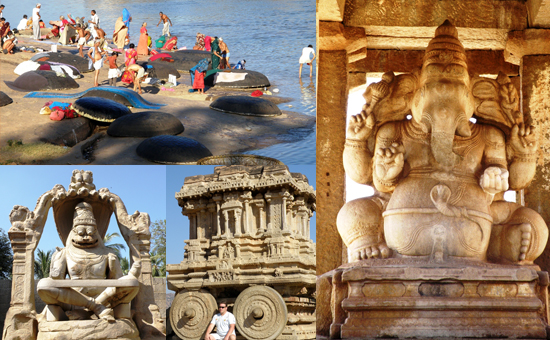 Hampi. India was
saved from complete destruction due to patronage of the Vijayanagara rulers.
Hampi. India was
saved from complete destruction due to patronage of the Vijayanagara rulers.
Timur,
a Turkish autocrat had two objects in invading India, first to put Islam on a firm
footing by destroying the kafirs and second to plunder the fabulous wealth and
valuables of the infidels. Timur let loose the horrors of barbaric warfare on
the plains of India. The climax was reached in the cold-blooded massacre of 1,00,000 Hindu prisoners outside the
plains of Delhi.
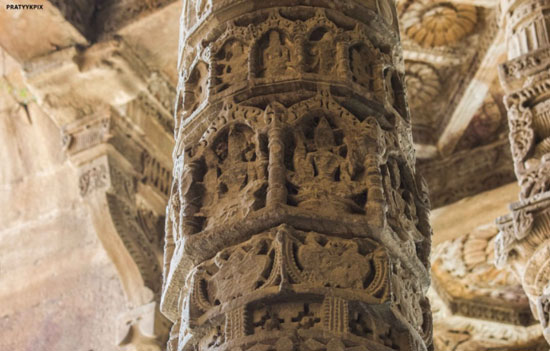 Disfigured column. A temple in Ajmer became Adhai din ka Jhopda around 1192.
Disfigured column. A temple in Ajmer became Adhai din ka Jhopda around 1192.
A
century later India was visited by the Portuguese, fleet under Vasco da Gama.
For nearly 2 centuries he and his followers brought untold miseries upon the
people living in the coastal regions, and Portuguese became a byword for cruelty in India.
Historians
have generally failed to point out the strong resemblance between the two. Both
were inspired the same motives-acquisition of wealth and promotion of religion.
Their
victories exposed the serious defects in the defence system of India, caused by
manifold developments in the technique of warfare, both by land and sea, in
countries far beyond the frontiers of India. Both
these lessons were lost upon men and rulers of India.
However,
the silver lining. The rise of Independent States meant more courts and thereby
the centres of patronage. It led to the development of provincial styles which
increased both the variety and productivity in art and architecture.
II History writing then
Although
the political history of the 14-15th centuries is marked by the same
lack of political cohesion that characterized the history of India since the
fall of the Gurjara-Pratihara empire in the 10th century a.d,, yet the
historical pictures of these two periods are not exactly the same. For that we
must thank Muslim historians.
A
serious drawback of all historical writers of the period is that their vision
seldom extended beyond the court, the capital, the rulers etc. Special mention
must be made of Ibn Natutah, who lived in India for 13 years and travelled
widely across the country. Thus, his account of Indian life is held with a high
degree of authenticity.
III Religious life and Language Literature then
It
was the age of mystic saints like Ramananda, Kabir, Chaitanya and Nanak whose
noble lives and religious teachings may be looked at as the richest legacy of
the period. Though their direct influence over India as a whole, may not have
been very considerable, their teachings have permeated the very texture of
Indian life.
Partly
as a result of patronage of many of the saints, but mainly in consequence of
the gradual process of evolution, the major spoken languages of India had a
phenomenal development and produced a rich literature.
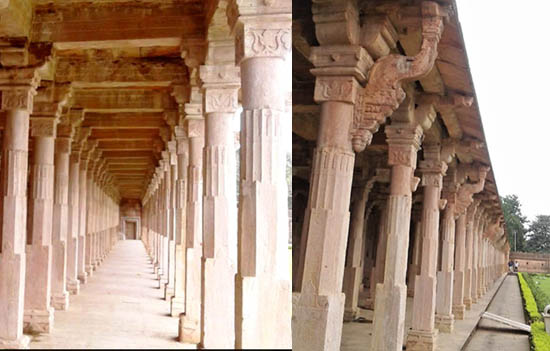 Jami Masjid, Mandu completed 1454. Left colonnade with pillars. Right pic is Hindu style brackets supporting the 3rd row of pillars.
Jami Masjid, Mandu completed 1454. Left colonnade with pillars. Right pic is Hindu style brackets supporting the 3rd row of pillars.
IV Impact of Islam
Muslims
settled in India in large numbers but kept themselves severely aloof from the
normal current of the social and religious life of the country. Unlike earlier
invaders, the Muslims did not form with the Hindus a single type of homogenous
culture. So, two distinct but important communities and cultures stood face to
face and India was permanently divided.
Political
necessities during the last phase of British rule underlined the importance of
alliance between the two communities and this was sought to be smoothly brought
about by glossing over the differences and creating an imaginary history of the
past in order to depict relations between the two in a much more favourable
light then it actually was.
A fear of wounding the susceptibilities of the sister community
haunts the mind of Hindu politicians and historians. But history is
no respecter of persons or communities and must always strive to tell the
truth. Ignorance of the actual relationship between Hindus and Muslims, an
ignorance deliberately encouraged by some, may ultimately be found to have been
the most important single factor which led to the partition of India.
The
above policy clearly brought out the differences which stood as barriers
between Hindus and Muslims. These are primarily on account of religious bigotry
by Muslims and social bigotry by Hindus. These differences are generally sought
to be explained or minimised for e.g. the oppressive acts of bigoted Muslim
rulers like Firuz Tughluq and Sikander Lodhi.
So
also the end of Hindu rule and destruction of temples and monasteries by
Muslims, very nearly extinguished Hindu culture. India was saved from this
disaster of complete destruction by the patronage of the rulers of Vijayanagara
and Mithila (Bihar).
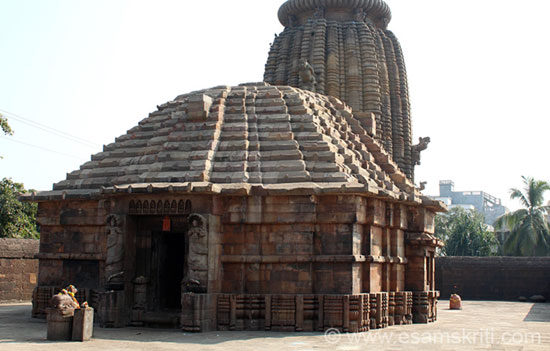 Megheshwar Mandir Bhubaneswar, attributable 12-13th century.
Megheshwar Mandir Bhubaneswar, attributable 12-13th century.
V Persecution of Chaitanya
The
patronage of literature in spoken languages by a few Muslim rulers is only
redeeming feature in general of Muslim attitude to Hindu culture. The high
development of literature and philosophy of the Chaitanya school of Vaishnavism
is regarded as a sign of revival during this period. Remember that out of
hundreds of Muslim rulers and officers in Bengal, only three Husain Shah, his
son Nusrat Shah and his general Paragal Khan are known to have patronised
Bengali poets whose flattering of their Muslim patrons is disgusting to modern
taste.
Persecution
of Chaitanya and his followers in the hands of the officers of Husain Shah must
be remembered. Note that of the 24 years he remained in his mortal frame after
he renounced the world, he hardly spent a year in dominion of Muslim rulers but
lived for 20 years in the Hindu kingdom of Orissa.
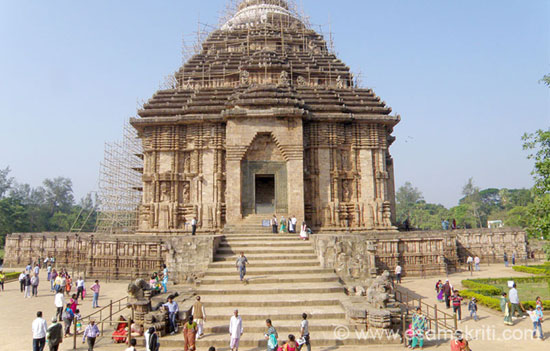 Sun Temple Konarak built 1250 AD
Sun Temple Konarak built 1250 AD
After
the 13th century notable specimens of Hindu art are to be found only
in the Hindu States of Vijayanagara and Mewar. Hindu culture did not flourish
under Islam.” End of quote.
The above excerpts
are courtesy and copyright the publisher the Bharatiya Vidya Bhavan, Kulapati K.M.
Munshi Marg, Mumbai-400007, India.
eSamskriti has obtained permission to share from the Editorial Advisory
Board of Bharatiya Vidya Bhavan.
To
read full Foreword visit the Bhavan site and HERE (shall be uploaded shortly)
To buy
book The History and Culture of Indian People at Bhavan’s
Online Store or on
Amazon
To
subscribe to the Bhavan’s Journal To
read on Culture
To
read Vande Mataram (English translation by Sri Aurobindo)
Also read
1. About
Vijayanagar Kings/Empire
2. The
story of Islamic Imperialism in India
3. Sacking
the Subcontinent Taimur
4. Album
Adhai din ka Jhopda
5. Album
Mandu-Hindu origins of
many monuments in Mandav seems clear
6. All
you wanted to know about Hampi